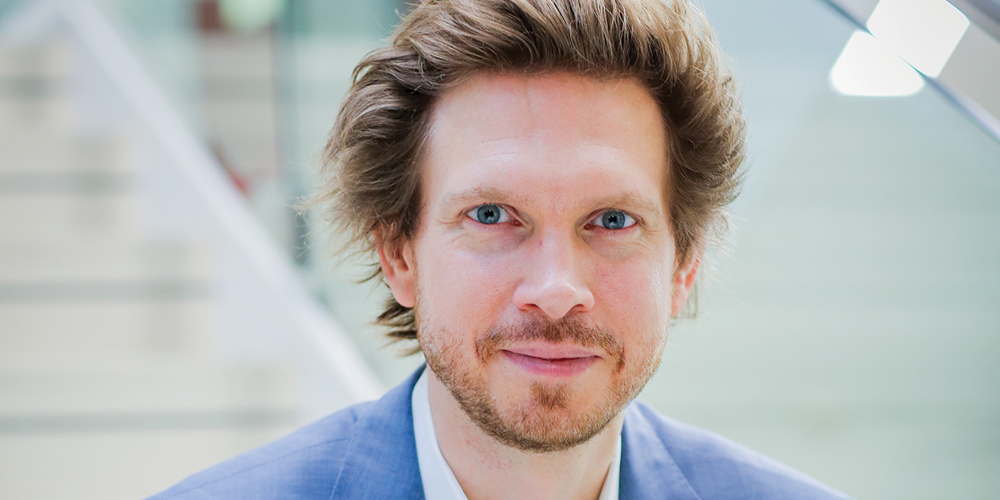Connecting the dots in an uncertain world
Business professor Christian Busch makes the case that serendipity is a skill, resulting from a mindset that allows you to see and act on opportunities in seemingly unrelated facts or events.
A version of this article appeared in the Winter 2020 issue of strategy+business.
In 1945, a U.S. defense contractor employee was working on the magnetron, a microwave-emitting tube used in radar systems to detect Nazi warplanes, when he noticed something unexpected: The bar of chocolate in his coat was melting. Percy Lebaron Spencer hadn’t been the first to observe this effect of the magnetron, but he was the first to be curious enough to experiment with it. With a prototyped metal box and a high-density electromagnetic field, he investigated its effect on different foods, such as popcorn and eggs. The first microwave was born, with a helping hand from serendipity.
In his new book, The Serendipity Mindset, Christian Busch, director of the global economy program at New York University’s Center for Global Affairs [now at the University of Southern California's Marshall School of Business], makes the case that serendipity is the result of a sensibility that allows people to spot and act on unexpected, fortuitous connections when others would dismiss them. And he suggests that it’s possible for people to cultivate this mindset and use unpredictability to their advantage. Busch talked to strategy+business about the serendipity mindset, which he says is key for companies in a time of pressing global challenges.
S+B: You view serendipity as being within our control. Can you explain?
BUSCH: It is commonly assumed that serendipity is just something that happens to us. But once you look deeper into stories of serendipity and how they unfolded, you see that it’s usually the result of being able to spot potential serendipity triggers, or unexpected events that connect to something that is relevant or meaningful.
But you can’t stop there. Once you’ve connected the dots, serendipity requires the tenacity to follow through with the unexpected discovery. One of the best examples of this is the story of two researchers, one at Cornell and the other at New York University, both of whom observed that the ears of the rabbits they were studying flopped when they were injected with the enzyme papain. Both found it unusual, but only NYU’s Lewis Thomas would follow up on it much later, in the 1950s, and his experiments would lead to the discovery of underlying factors in rheumatoid arthritis.
The reason people miss serendipity is that they don’t notice the unexpected, or they do notice but then don’t connect the dots. But in many cases, it’s the lack of tenacity and the unwillingness to take a chance that account for the loss of serendipitous opportunities. That’s why I’m certain it’s about “smart luck.” It’s not about the kind of luck associated with being born into a good family or having access to a good education, but about really working for that luck.
S+B: Why is having a serendipity mindset important in today’s circumstances of extreme uncertainty and multifront challenges?
BUSCH: We live in a world that underestimates the unexpected and prizes linear thinking and the illusion of control. But life, as well as business, is more emergent than that, as the global pandemic and Black Lives Matter protests have shown. We plan things in one way, and something else happens. Some people leverage that sort of change into positive outcomes and others don’t. In my research into what makes individuals and organizations fit for the future, one insight has come up again and again: It turns out that many of the world’s leading minds have, often unconsciously, developed a capacity to cope with the unexpected. This ability, which I call a serendipity mindset, allows for the unexpected to be viewed as an opportunity rather than a threat.
Serendipity is about ‘smart luck.’ It’s not about the kind of luck associated with being born into a good family or having access to a good education, but about really working for that luck.”
And society is expecting this sort of leadership from the business world. Research — including a study with 31 of the world’s leading CEOs that I did with colleagues from the consultancy Leaders on Purpose and Harvard University — shows that the public is increasingly looking to business leaders to play a large role in solving complex societal and environmental problems. This new paradigm requires leaders to combine a sense of meaningful direction, or purpose, with an appreciation of the unexpected, reframing challenges and relating them to core capabilities. That’s what’s happening when breweries turn into hand sanitizer companies and design companies turn into high-end mask producers. The serendipity mindset is part of a larger shift that is taking place in the cultures and values of some of the world’s biggest corporations and their leaders. It allows us to use uncertainty and unpredictability as a pathway to innovation, impact, and smart luck by seeing and connecting the dots.
For example, Peter Agnefjall, IKEA’s CEO from 2012 to 2017, told us in an interview that he would have laughed at us had we told him five years ago that IKEA would own wind farms and solar power installations. He hadn’t expected that committing to “being sustainable” would mean investing in renewable energy in order to be able to independently power the company’s buildings in a sustainable way. “But when I look back, that’s what we do now, right?” he said. Serendipity demands a conscious effort to prompt and leverage those moments when apparently unconnected ideas or events come together in front of you to form a new pattern.
S+B: What can businesses do to help their people develop a serendipity mindset?
BUSCH: Three processes that are easy to implement are cultivating serendipity spotting, de-risking ideas, and developing an environment of trust.
At the heart of serendipity — and eventually, innovation — is bisociation, which is the ability to connect unrelated facts or events. Cultivating serendipity spotting is all about getting our colleagues or employees to pay attention to the unexpected, in the big and the small.
For example, leaders can ask team members in routine meetings if they came across something surprising last week related to work. And if the answer is yes, they can ask if it changes their assumptions — for example, in terms of marketing strategy — and if it would be valuable to follow up on it? This alertness can lead to identifying wrong assumptions — and new, surprising solutions or market demands.
For example, if someone on your team has observed farmers unexpectedly using their washing machines to wash potatoes, instead of ignoring it or telling farmers not to do it, your company could build a dirt filter into a washing machine and label it as a potato washing machine, as a Chinese multinational company did. Farmers’ need to wash their potatoes unexpectedly correlated, in this case, to the company’s ability to deliver a product that could help them do that.
This serendipity-spotting mindset goes hand in hand with de-risking ideas and facilitating an environment of trust. An environment that encourages risk-taking and cross-pollination of ideas increases serendipity.
One example of how to create this environment is by doing “project funerals,” or postmortems. When a project — for example, a new technology that was brought to market — doesn’t work out, the respective project manager “lays it to rest” in front of colleagues from other divisions and reflects on why it did not work out and what can be learned from it. This is not about celebrating failure — it’s about celebrating the learning from failure. What often happens is that people in the audience “coincidentally” connect it to a project that they are working on, and elements of the project are then unexpectedly repurposed for another use.
In one major health, materials, and nutrition company, for example, a coating for nonreflective picture-frame glass was deemed unviable for the market. At the project funeral, however, one of the attendees outside the original team realized the technology’s utility for solar panels. The unexpected idea was tested and found to have merit, and the company ended up with a strong solar unit. These “lucky” outcomes become more probable if companies put these serendipity-friendly processes into place.
S+B: Of all the biases you write about in your book that hinder serendipity — underestimating the unexpected, conforming to the majority, post-rationalization, and functional fixedness — which ones do you see as being most prevalent?
BUSCH: A tendency to underestimate the unexpected — both the chance of it happening and the potential in it — is a common one. To combat this bias, instead of doing “risk management,” which tends to focus on known unknowns, you can build a muscle for planning for and finding potential in the unexpected. This will be what counts during periods of crisis and uncertainty. One way of doing this is to develop a North Star you can use to connect unexpected events to your mission.
Take Kaan Terzioglu, CEO of Turkish telecom company Turkcell from 2015 to 2019. When there was an outbreak of serious violence in Turkey in 2016 following an attempted coup d’etat, Kaan and his team responded by making the Internet free for a month so people were able to communicate with those they cared about without worrying about bills. And during a regional refugee crisis, the company’s quick and proactive actions to develop an app to help Syrian refugees find crucial health and financial information in the country calmed tensions in the camps. As Turkcell has built on this initial app, adding more services, customer loyalty among the refugee population has given Turkcell a major market share among the 3 million Syrian refugees in Turkey. Although it might seem odd to associate the term serendipity with this example, since serendipity has a positive connotation and these events were very serious and tragic, this is a very good example of a company being guided by its core values when unexpected events create an opportunity for the business to be of service.
S+B: Your book warns about core competencies becoming core rigidities, and how this phenomenon becomes another bias that inhibits a serendipity mindset. What is the antidote?
BUSCH: Deep domain expertise makes bisociations easier, but it can also lead to functional fixedness — the “if you have a hammer, everything looks like a nail” problem. What often happens is that because we are so used to a particular strategy, tool, or solution, we don’t see new or simpler ways of doing things. The familiar way of approaching something then becomes a limitation.
For example, if you live in a city full of ATMs, your way of innovating might be to think about how to develop a better ATM. Kenya’s M-Pesa is a great example of the converse. Given Kenya’s less developed banking system and ATM networks, especially in rural areas, M-Pesa wasn’t trapped by preconceptions. Instead of developing a “better ATM,” it developed a mobile-based money transfer system.
There are many ways you can counter the functional fixedness bias in order to spot serendipity triggers and innovate. For example, you can reformulate questions and problems in a more open-ended way to provide direction without superficially narrowing the possibilities for solution. Reframing is another effective counter to this bias. It allows for new solutions to emerge through interest-based explorations, rather than taking a position-based approach, which can be limiting. For example, in a negotiation, if one party can be open to letting go of its position to capture the underlying needs and interests of the other party, it can lead to unexpected shifts and solutions that wouldn’t have otherwise emerged. The same applies to finding new solutions for needs or problems.
Importantly, combating this bias is also about developing a sense of humility — a sense that you haven’t figured it all out. We all need to become practical philosophers, asking “why” all the time, and not taking existing structures or processes as givens.
S+B: What can leaders do about the fact that many company cultures still prize certainty over risk-taking?
BUSCH: Our researchPDF has shown that effective leaders value a questioning mind, and practice and instill curiosity in their companies. This often allows them to reframe capabilities and problems, especially during times of uncertainty.
Procter & Gamble’s CEO David Taylor makes the crucial link between creating an environment of learning and being able to make novel connections that spur fresh solutions, explaining to me for the CEO survey I did with Harvard University and Leaders on Purpose that “the idea is to train managers not to be in evaluation mode but in developing mode.” He sees this as necessary to creating environments that place a value on learning over being right.
Leaders who foster this learning culture understand that the future viability of a company is not only about innovation or R&D departments — it’s about everyone across the company constantly seeing and connecting dots. But this requires a collective openness toward new ideas, too, and it links to the de-risking of ideas. If they don’t feel safe, people will not come up with new ideas or solutions.
S+B: You’re referring to psychological safety?
BUSCH: Yes, how safe we feel within the workplace and with our colleagues has a profound impact on serendipity. Psychologically safe environments make people feel free to speak up about unexpected discoveries, incomplete hypotheses, and seemingly crazy ideas. Harvard professor Amy Edmondson’s decades-long work in this area places psychological safety at the center of a healthy corporate culture and performance. Her studies show that better-performing teams are ones that talk more about mistakes, whereas in lower-performing teams, mistakes are often swept under the carpet. I have witnessed this in many of the organizations I work with; projects that fail are silently buried, and with them the chance for others to benefit by learning from them. On the other hand, companies such as Pixar have created an environment where leaders like cofounder Ed Catmull openly acknowledge mistakes. In meetings, the tone for openness is set by admissions such as one he made in his book, Creativity, Inc.: “Early on, all our movies suck.” This practice of talking about mistakes allows team members to safely push back and ask critical questions, but it has the added benefit of recognizing failed efforts quickly, minimizing losses, and learning valuable lessons.
S+B: In the book, you emphasize the idea of leaders and companies “placing diverse bets.” What do you mean by this, and how do you see this playing out in organizations?
BUSCH: The value of placing bets is that it allows opportunities to emerge based on new interactions, insights, and revelations. Enlightened leaders, for example, are increasingly placing bets in a number of ways, including through decentralized structures, or internal incubators that turn their companies into platforms. One of the ways that BMW trains its people in navigating a world full of uncertainty is by retraining current employees rather than hiring new people.
Another significant way of placing diverse bets is through the creation of microenterprises. Take a leading white goods Chinese company, which has been reorganized into a platform ecosystem, incentivizing people within and outside the company to engage with emerging data and ideas. This has spawned more than a thousand microenterprises — teams of people with an idea either based on an existing product or for something entirely new. The company uses this model to place diverse bets, realizing that 10 years from now, much of today’s technology might be obsolete, so they prepare for the unexpected.
In the end, how we place bets comes down to how comfortable we are with taking risks. But this is a shift that is beginning to take hold across industries, including in traditional strongholds such as banking. Johan Torgeby, CEO of one of Sweden’s largest banks, SEB Group, explained in his CEO study interview with me that people like him who thought mostly in financial measures, such as internal rate of return, were shifting toward a ‘‘tech investor” mindset of placing bets in a world that is based less on Excel sheets and more on belief.
S+B: One of the key points in the book revolves around the tendency of people to have a “control story” — the narrative that they make up retroactively about a serendipitous event, in order to show that they were always in control. What effect does this habit have on an organization’s culture?
BUSCH: The tendency to tell the control story is linked to the bias of post-rationalization, which is how we think about the past, always making sense out of things in hindsight. We perceive past events to be more predictable than they actually were, and then narrate the events in a linear, rational way that excludes the unexpected. This is a common phenomenon in companies, where leaders feel they can’t tell their boards and other stakeholders about the real serendipity story, because an admission of the unexpected shows they were not in control the whole time. A CEO once expressed to me that presenting an “official” story that indicated a planned, controlled process was expected by investors. Unfortunately, this practice deprives others of learning what really allowed an outcome to happen, and so they miss out on making connections when similar circumstances occur. In essence, airbrushing serendipity out of our history makes it far harder to spot when it happens again.
Telling the real serendipity story also connects to increased innovation. In the past, company cultures were fiercely competitive and closed, and they still are in many industries, such as finance. But in a fast-changing, highly networked world, where companies are becoming more fluid, the ability of people to pick up new things and take them back into the company is very valuable. What we’ll see over the next few years is not only that a lot of large companies are dying, but also that a lot of the companies that survive will be much better at networked intelligence, learning from external sources, and bringing innovation back into the company. These are more likely to be environments that encourage the open sharing of information and that legitimize the story and process of serendipity.
Author profile:
- Suvarchala Narayanan is a business writer, future of work researcher, and startup consultant. She lives in India and Europe.





